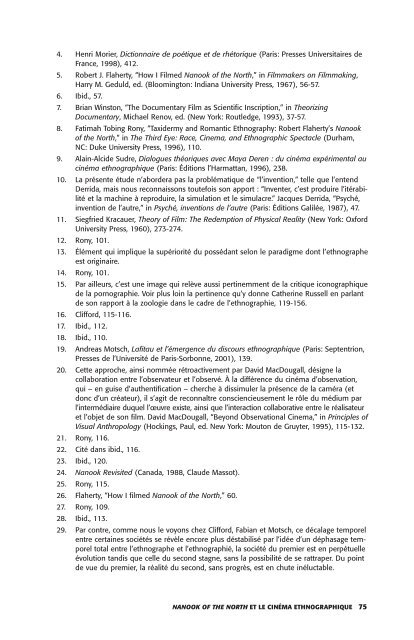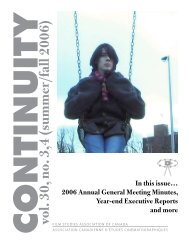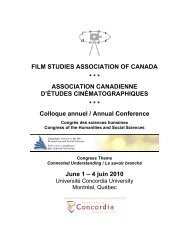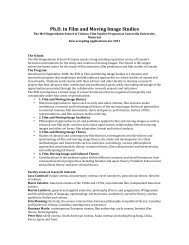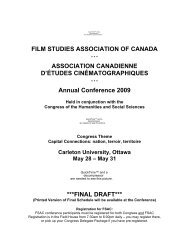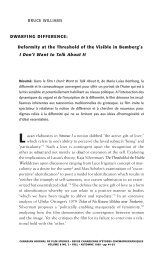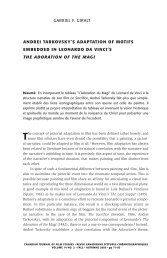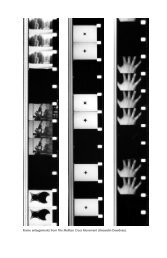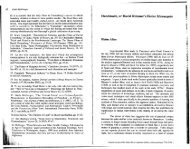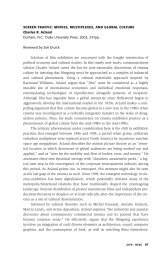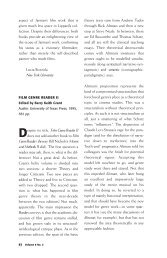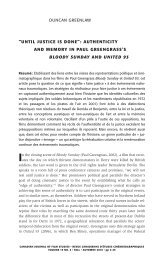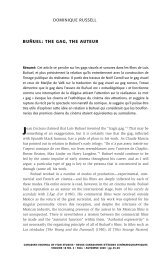Nanook of the North et le cinéma ethnographique - Film Studies ...
Nanook of the North et le cinéma ethnographique - Film Studies ...
Nanook of the North et le cinéma ethnographique - Film Studies ...
Create successful ePaper yourself
Turn your PDF publications into a flip-book with our unique Google optimized e-Paper software.
4. Henri Morier, Dictionnaire de poétique <strong>et</strong> de rhétorique (Paris: Presses Universitaires de<br />
France, 1998), 412.<br />
5. Robert J. Flaherty, “How I <strong>Film</strong>ed <strong>Nanook</strong> <strong>of</strong> <strong>the</strong> <strong>North</strong>,” in <strong>Film</strong>makers on <strong>Film</strong>making,<br />
Harry M. Geduld, ed. (Bloomington: Indiana University Press, 1967), 56-57.<br />
6. Ibid., 57.<br />
7. Brian Winston, “The Documentary <strong>Film</strong> as Scientific Inscription,” in Theorizing<br />
Documentary, Michael Renov, ed. (New York: Rout<strong>le</strong>dge, 1993), 37-57.<br />
8. Fatimah Tobing Rony, “Taxidermy and Romantic Ethnography: Robert Flaherty’s <strong>Nanook</strong><br />
<strong>of</strong> <strong>the</strong> <strong>North</strong>,” in The Third Eye: Race, Cinema, and Ethnographic Spectac<strong>le</strong> (Durham,<br />
NC: Duke University Press, 1996), 110.<br />
9. Alain-Alcide Sudre, Dialogues théoriques avec Maya Deren : du <strong>cinéma</strong> expérimental au<br />
<strong>cinéma</strong> <strong>et</strong>hnographique (Paris: Éditions l’Harmattan, 1996), 238.<br />
10. La présente étude n’abordera pas la problématique de “l’invention,” tel<strong>le</strong> que l’entend<br />
Derrida, mais nous reconnaissons toutefois son apport : “Inventer, c’est produire l’itérabilité<br />
<strong>et</strong> la machine à reproduire, la simulation <strong>et</strong> <strong>le</strong> simulacre.” Jacques Derrida, “Psyché,<br />
invention de l’autre,” in Psyché, inventions de l’autre (Paris: Éditions Galilée, 1987), 47.<br />
11. Siegfried Kracauer, Theory <strong>of</strong> <strong>Film</strong>: The Redemption <strong>of</strong> Physical Reality (New York: Oxford<br />
University Press, 1960), 273-274.<br />
12. Rony, 101.<br />
13. Élément qui implique la supériorité du possédant selon <strong>le</strong> paradigme dont l’<strong>et</strong>hnographe<br />
est originaire.<br />
14. Rony, 101.<br />
15. Par ail<strong>le</strong>urs, c’est une image qui relève aussi pertinemment de la critique iconographique<br />
de la pornographie. Voir plus loin la pertinence qu’y donne Ca<strong>the</strong>rine Russell en parlant<br />
de son rapport à la zoologie dans <strong>le</strong> cadre de l’<strong>et</strong>hnographie, 119-156.<br />
16. Clifford, 115-116.<br />
17. Ibid., 112.<br />
18. Ibid., 110.<br />
19. Andreas Motsch, Lafitau <strong>et</strong> l’émergence du discours <strong>et</strong>hnographique (Paris: Septentrion,<br />
Presses de l’Université de Paris-Sorbonne, 2001), 139.<br />
20. C<strong>et</strong>te approche, ainsi nommée rétroactivement par David MacDougall, désigne la<br />
collaboration entre l’observateur <strong>et</strong> l’observé. À la différence du <strong>cinéma</strong> d’observation,<br />
qui – en guise d’au<strong>the</strong>ntification – cherche à dissimu<strong>le</strong>r la présence de la caméra (<strong>et</strong><br />
donc d’un créateur), il s’agit de reconnaître consciencieusement <strong>le</strong> rô<strong>le</strong> du médium par<br />
l’intermédiaire duquel l’œuvre existe, ainsi que l’interaction collaborative entre <strong>le</strong> réalisateur<br />
<strong>et</strong> l’obj<strong>et</strong> de son film. David MacDougall, “Beyond Observational Cinema,” in Princip<strong>le</strong>s <strong>of</strong><br />
Visual Anthropology (Hockings, Paul, ed. New York: Mouton de Gruyter, 1995), 115-132.<br />
21. Rony, 116.<br />
22. Cité dans ibid., 116.<br />
23. Ibid., 120.<br />
24. <strong>Nanook</strong> Revisited (Canada, 1988, Claude Massot).<br />
25. Rony, 115.<br />
26. Flaherty, “How I filmed <strong>Nanook</strong> <strong>of</strong> <strong>the</strong> <strong>North</strong>,” 60.<br />
27. Rony, 109.<br />
28. Ibid., 113.<br />
29. Par contre, comme nous <strong>le</strong> voyons chez Clifford, Fabian <strong>et</strong> Motsch, ce décalage temporel<br />
entre certaines sociétés se révè<strong>le</strong> encore plus déstabilisé par l’idée d’un déphasage temporel<br />
total entre l’<strong>et</strong>hnographe <strong>et</strong> l’<strong>et</strong>hnographié, la société du premier est en perpétuel<strong>le</strong><br />
évolution tandis que cel<strong>le</strong> du second stagne, sans la possibilité de se rattraper. Du point<br />
de vue du premier, la réalité du second, sans progrès, est en chute inéluctab<strong>le</strong>.<br />
NANOOK OF THE NORTH ET LE CINÉMA ETHNOGRAPHIQUE 75


